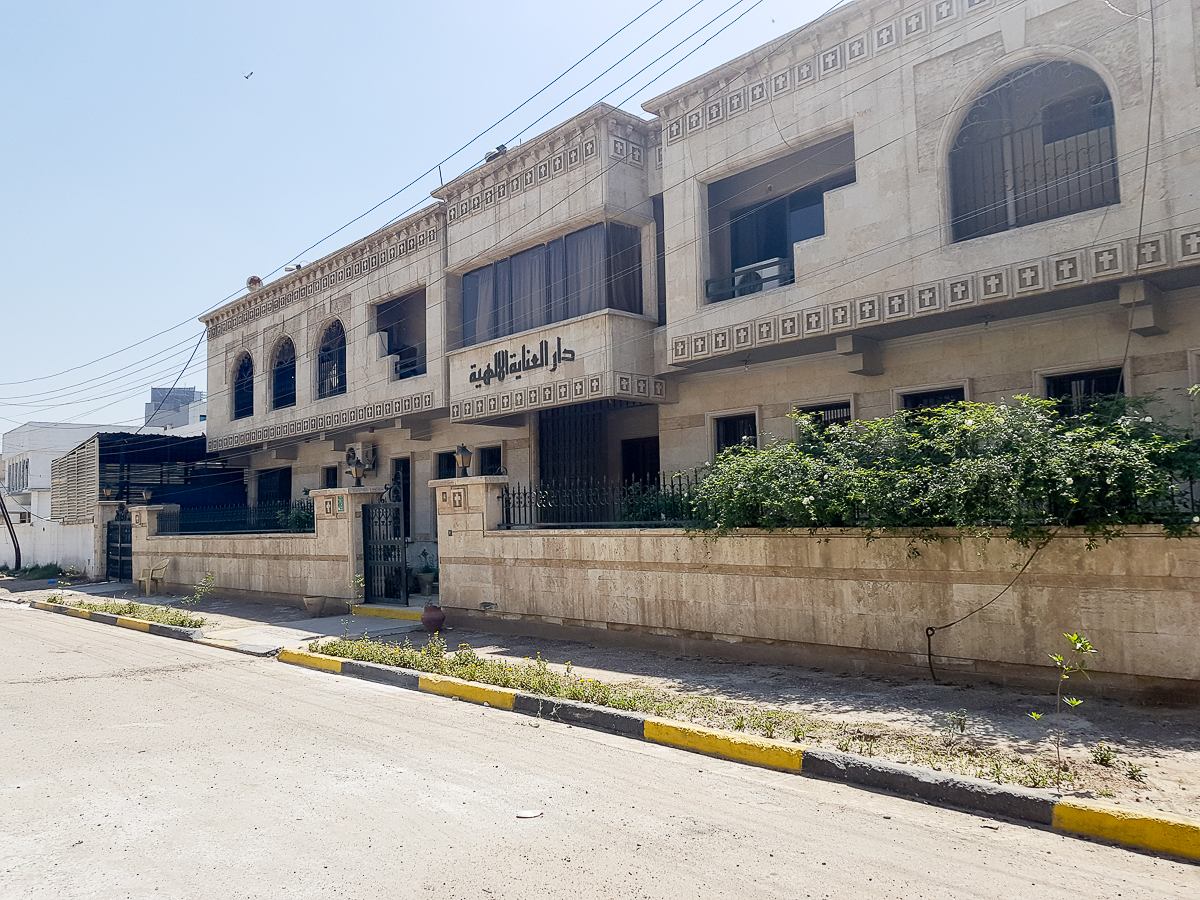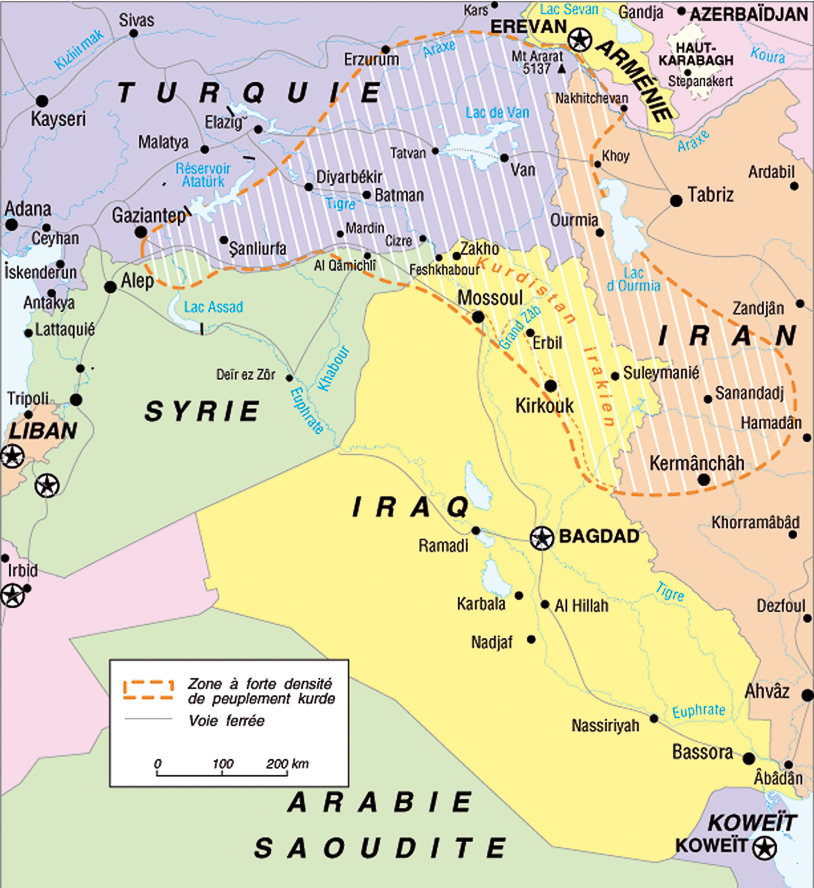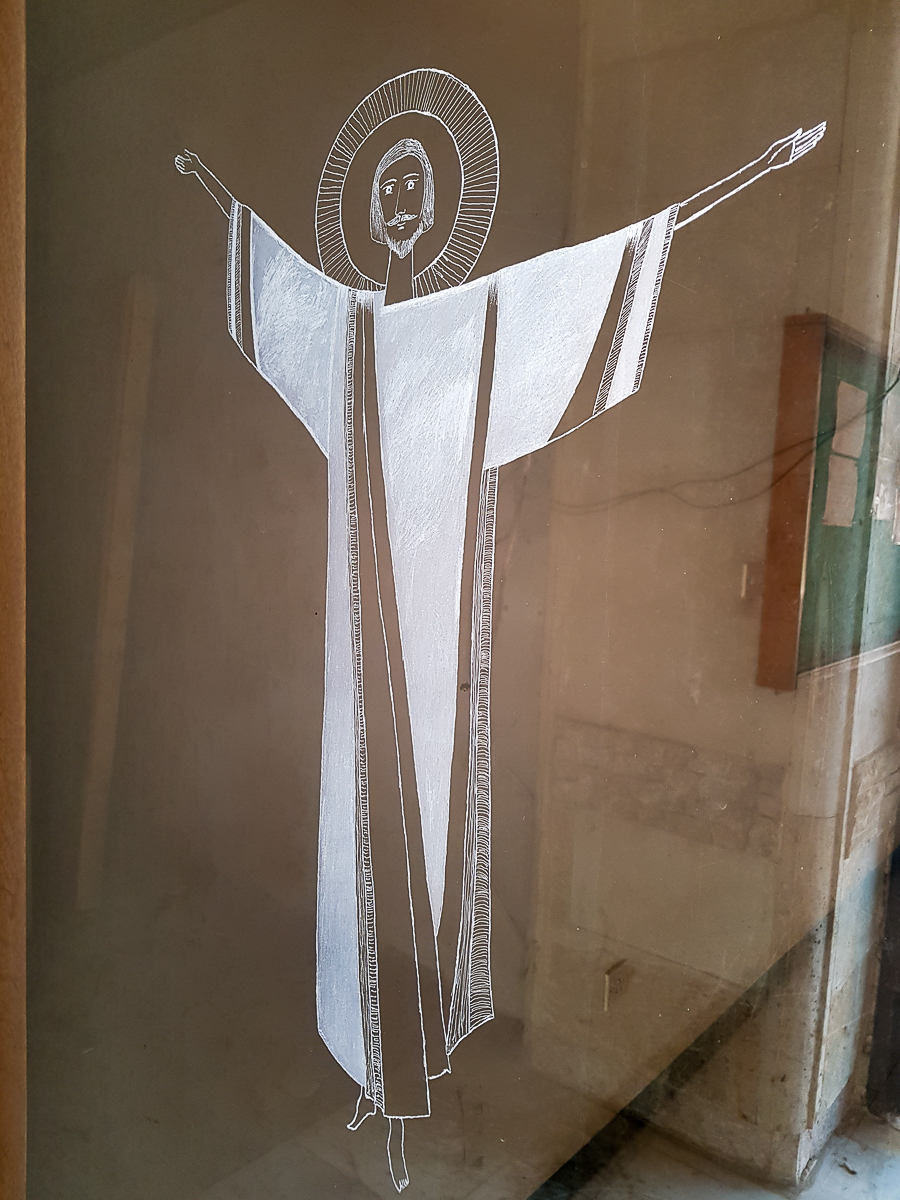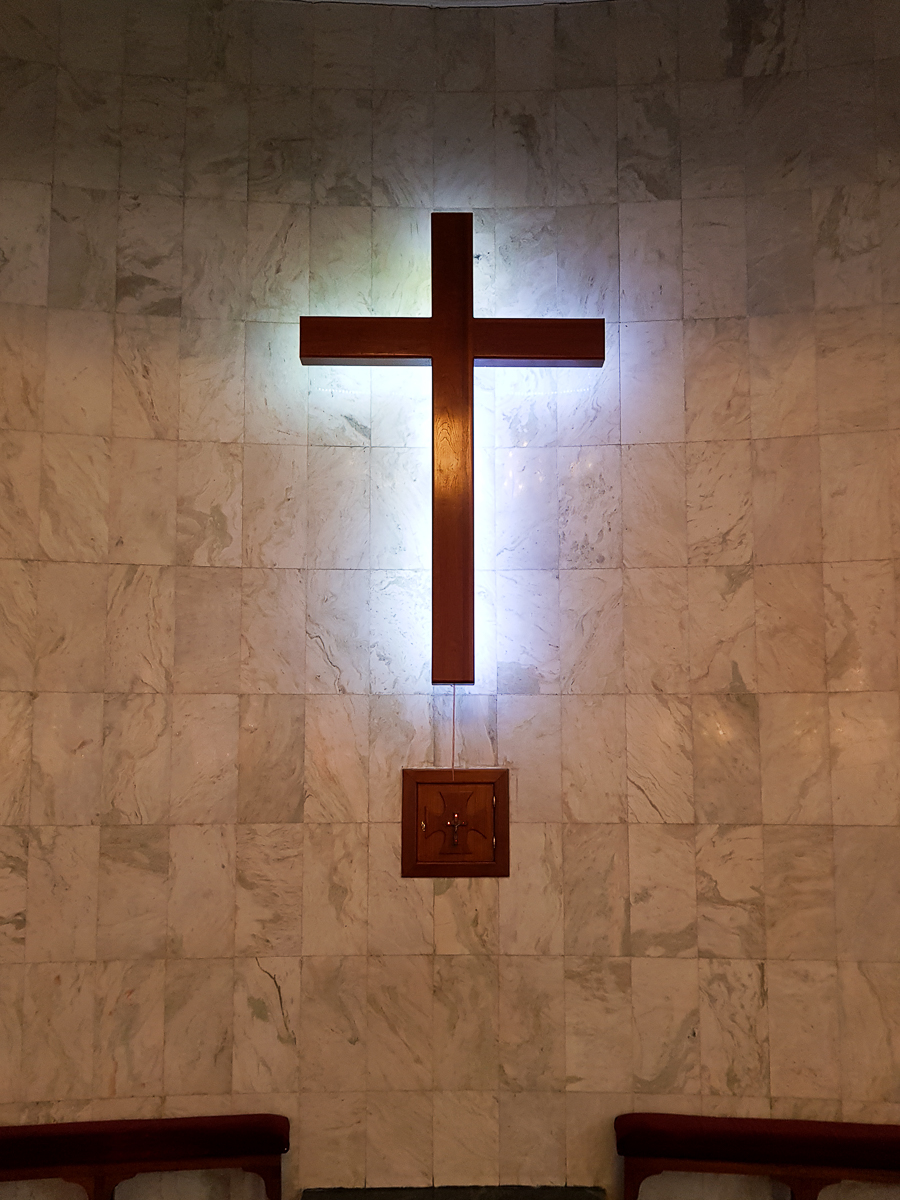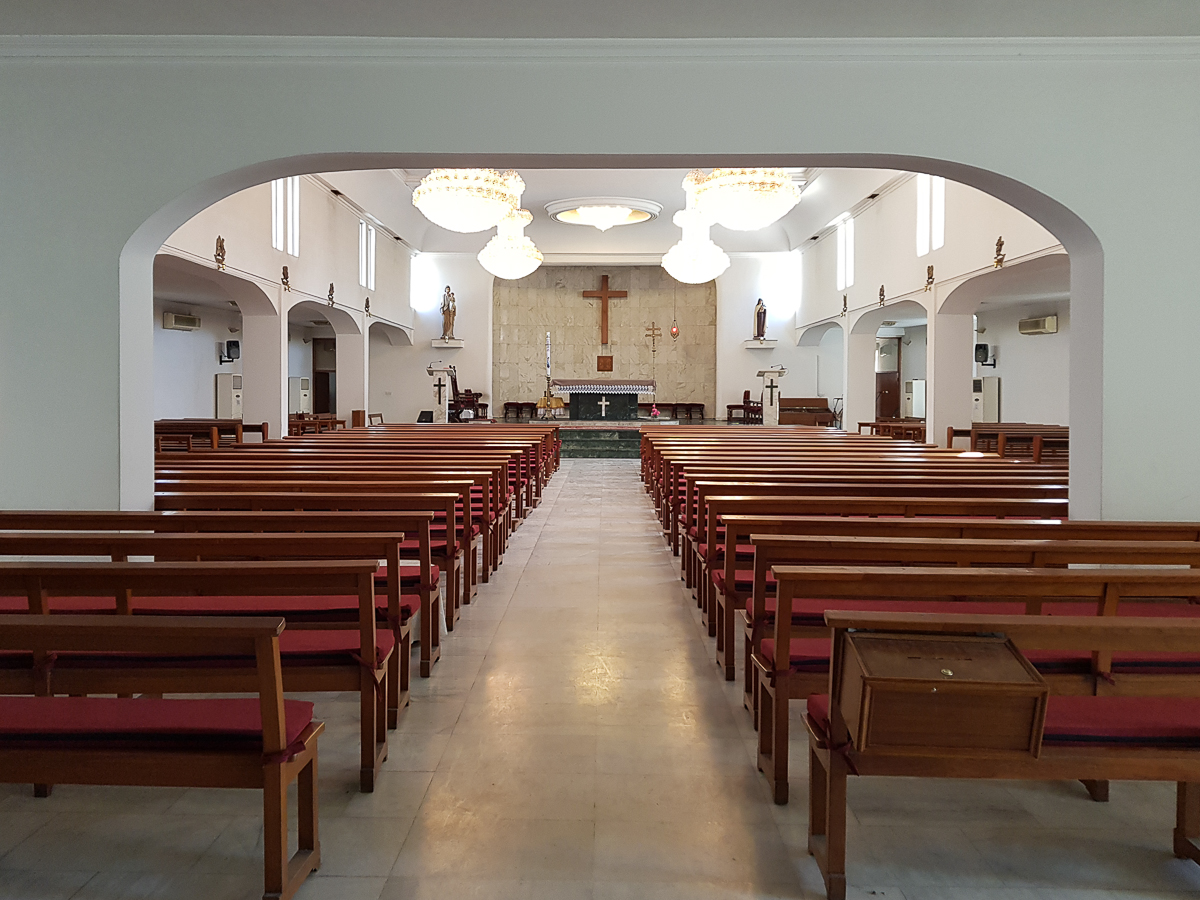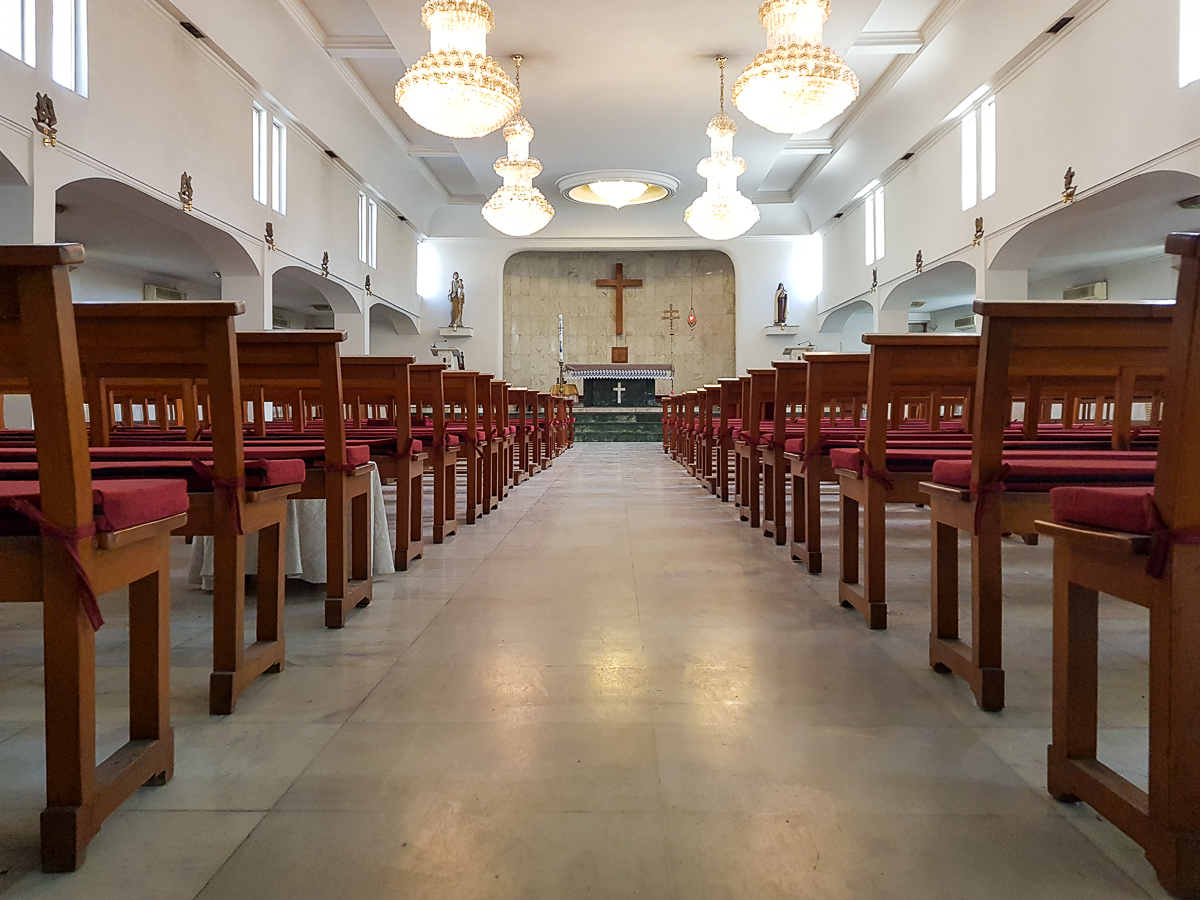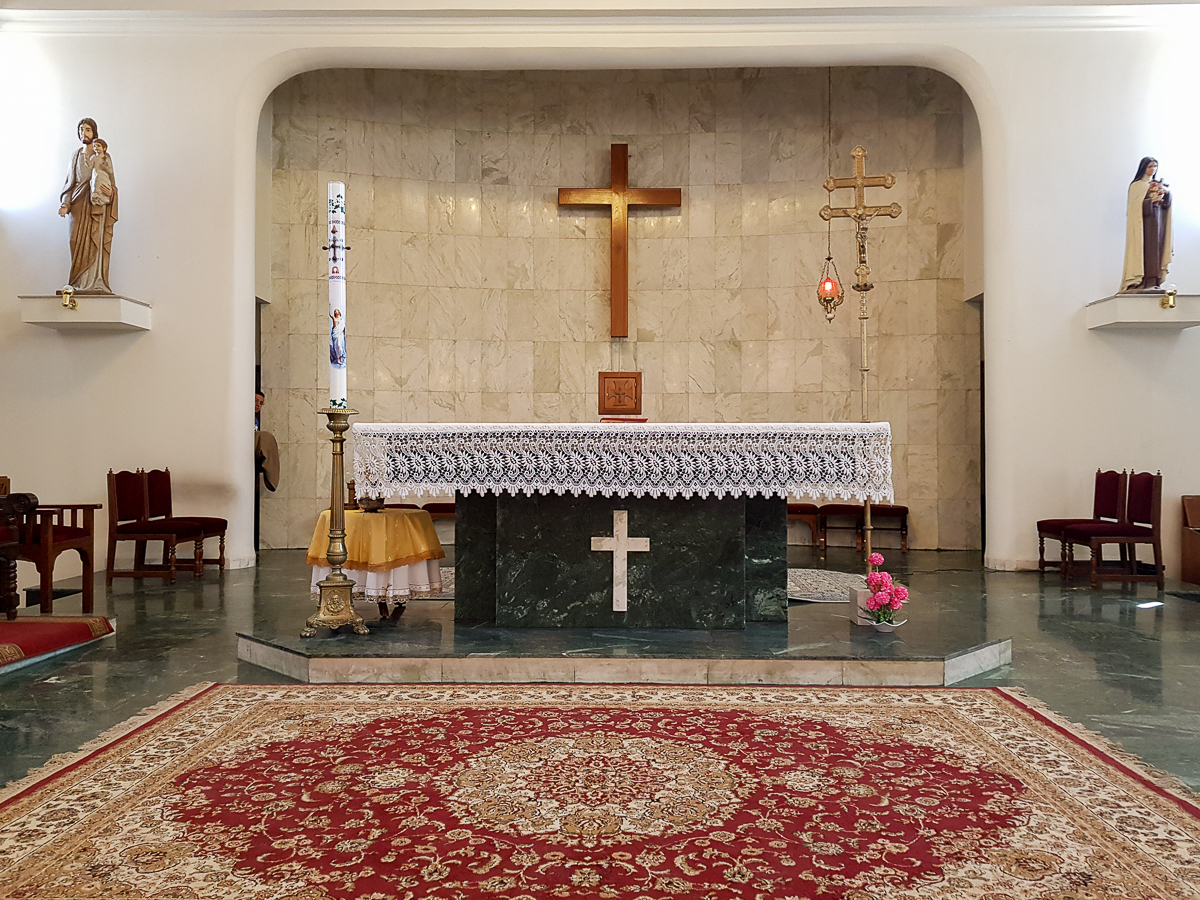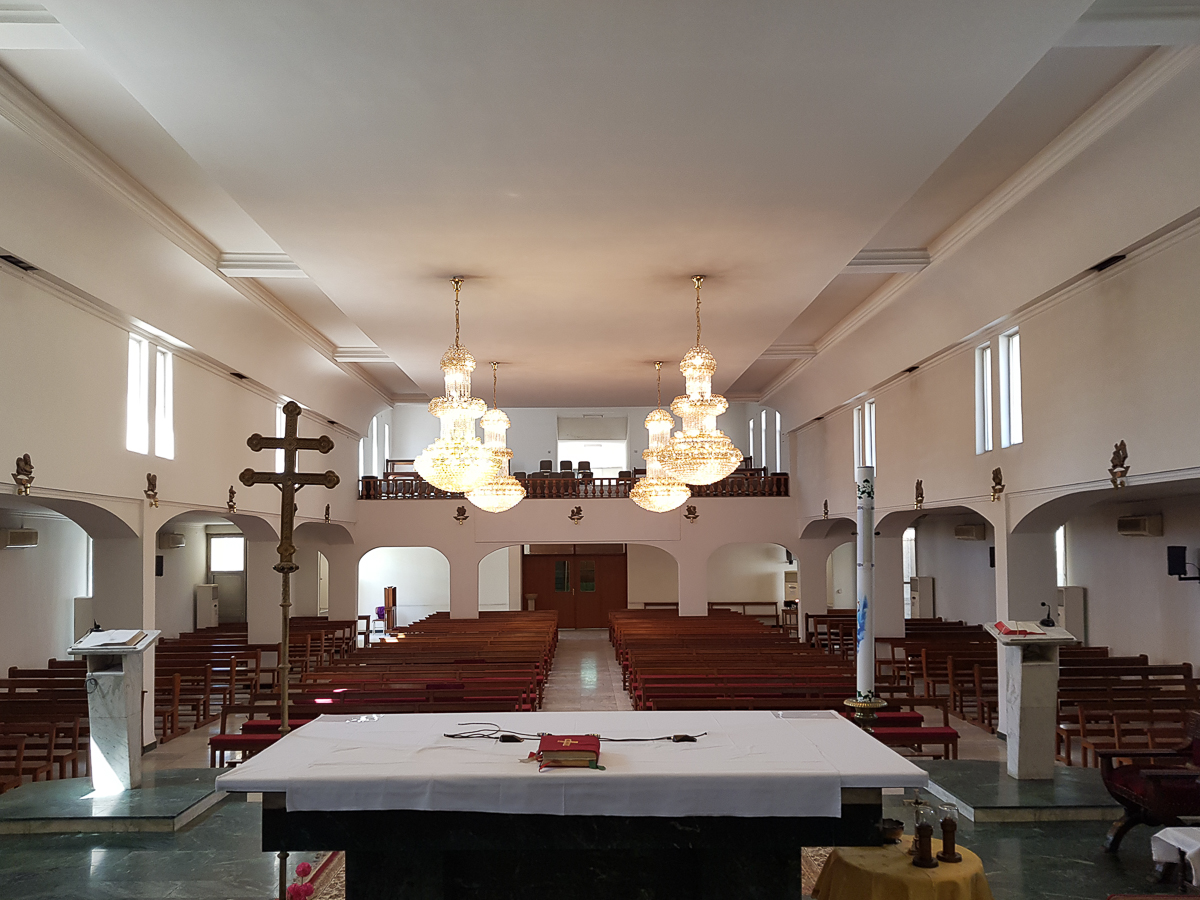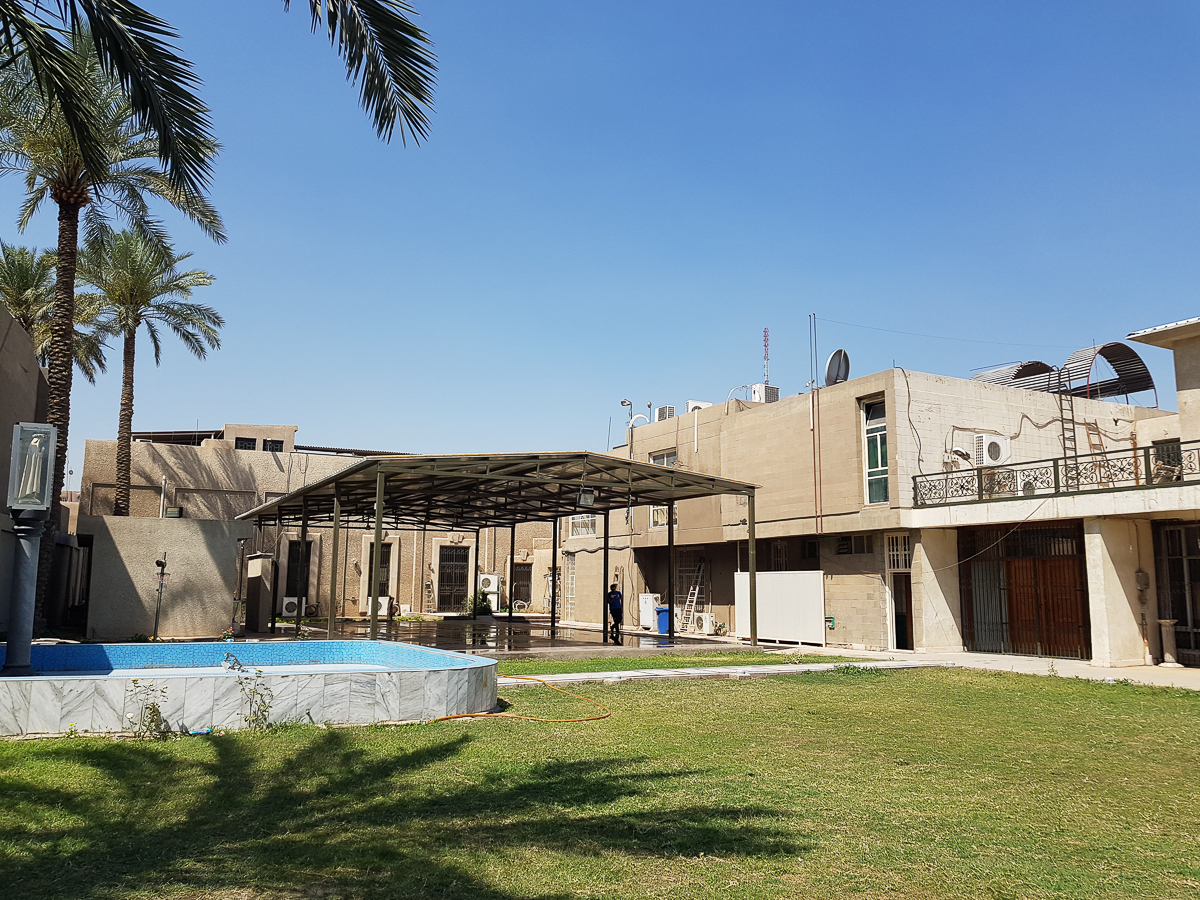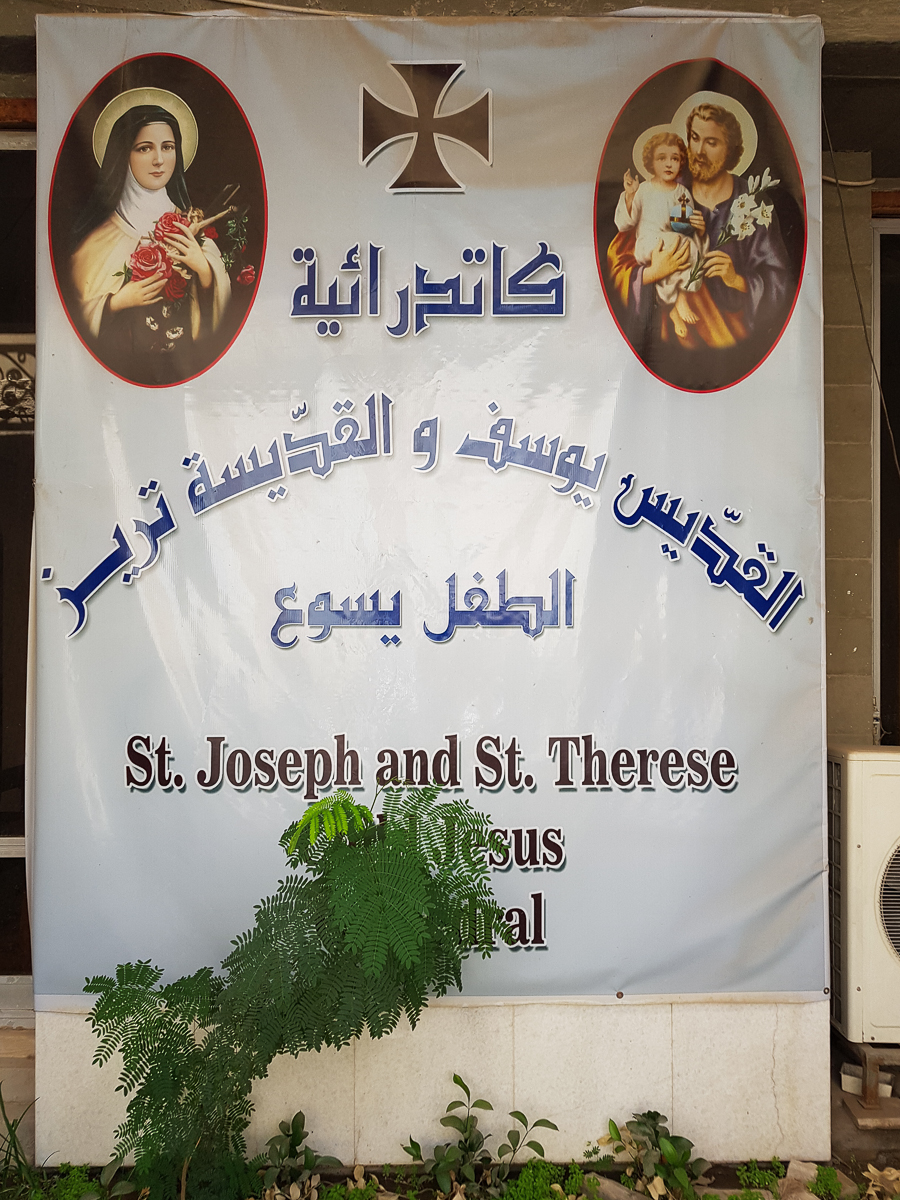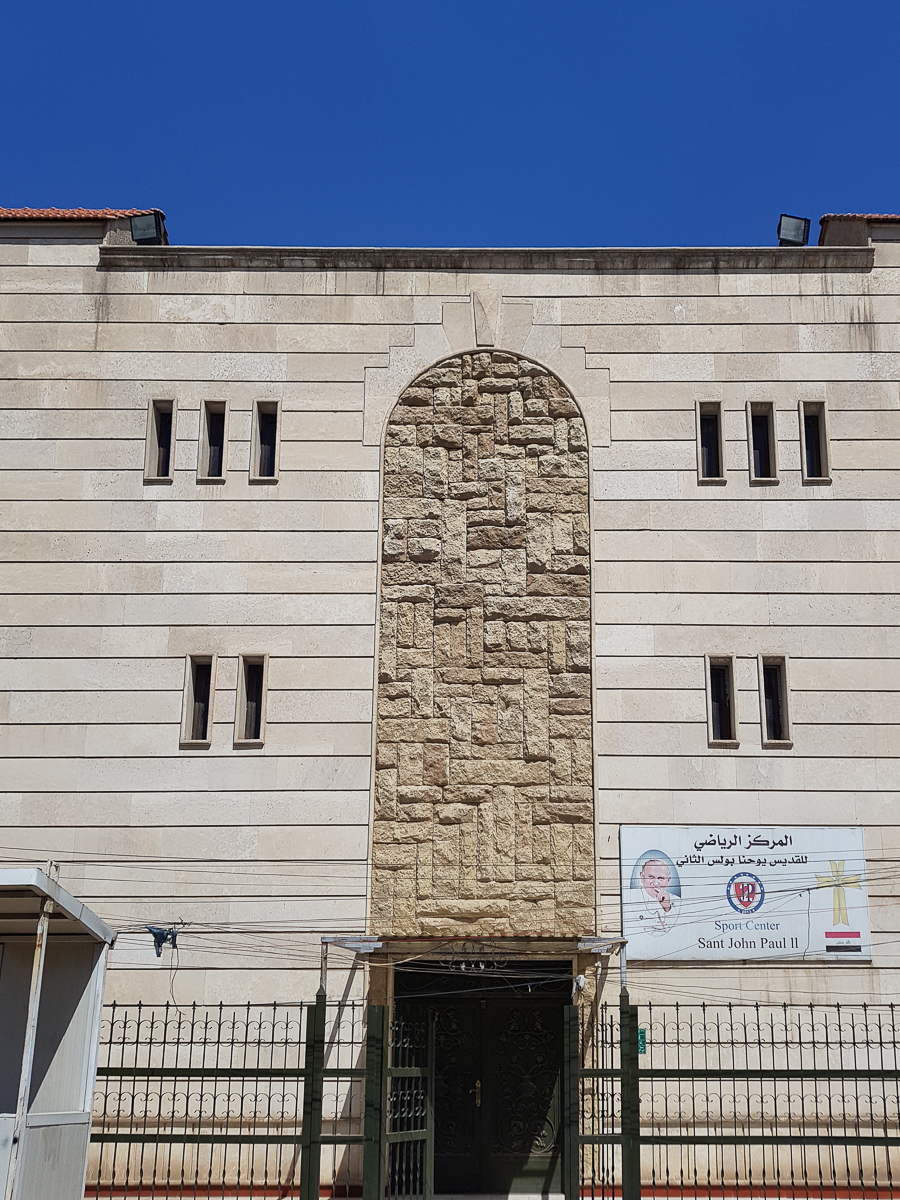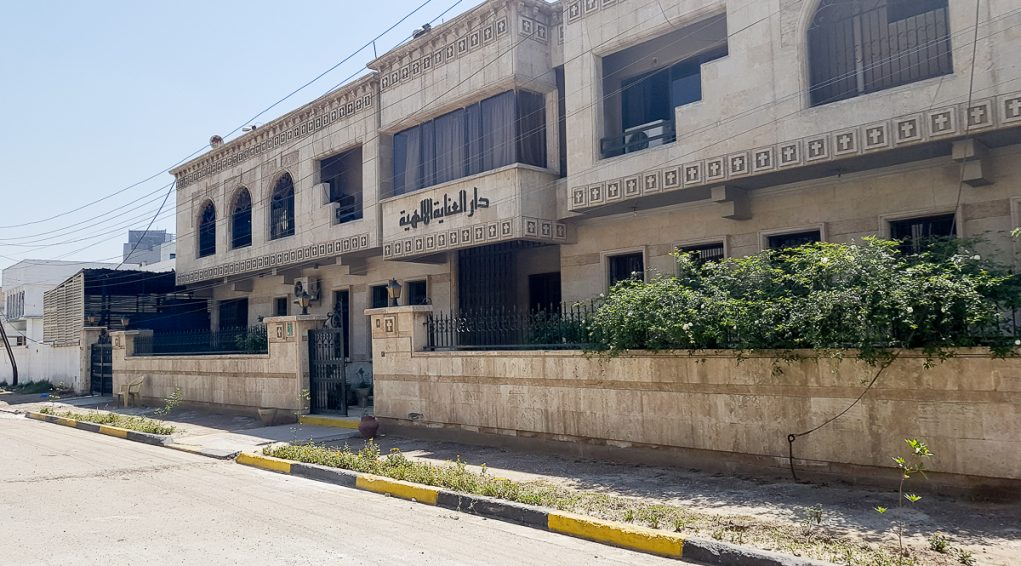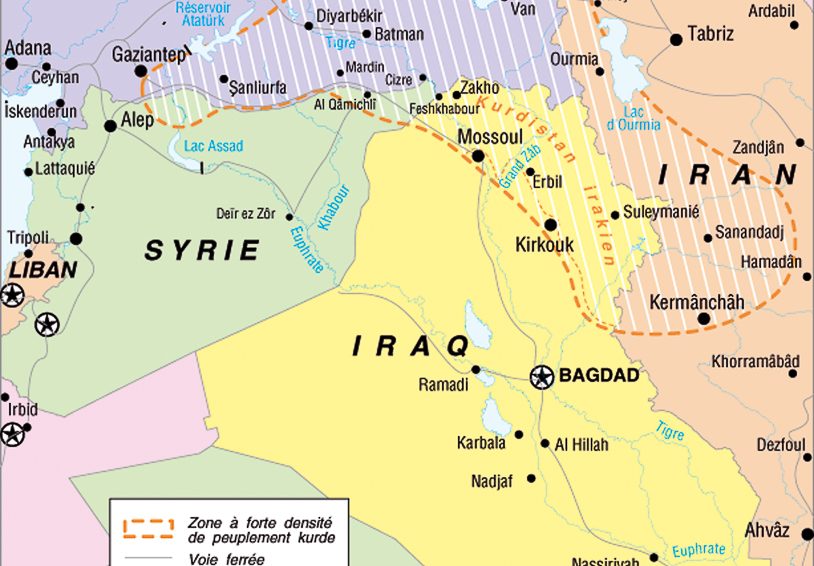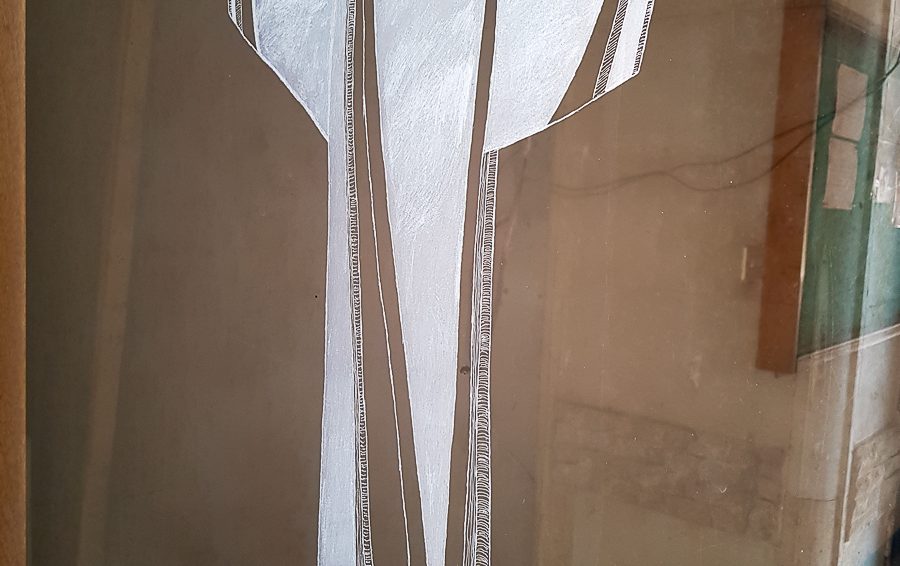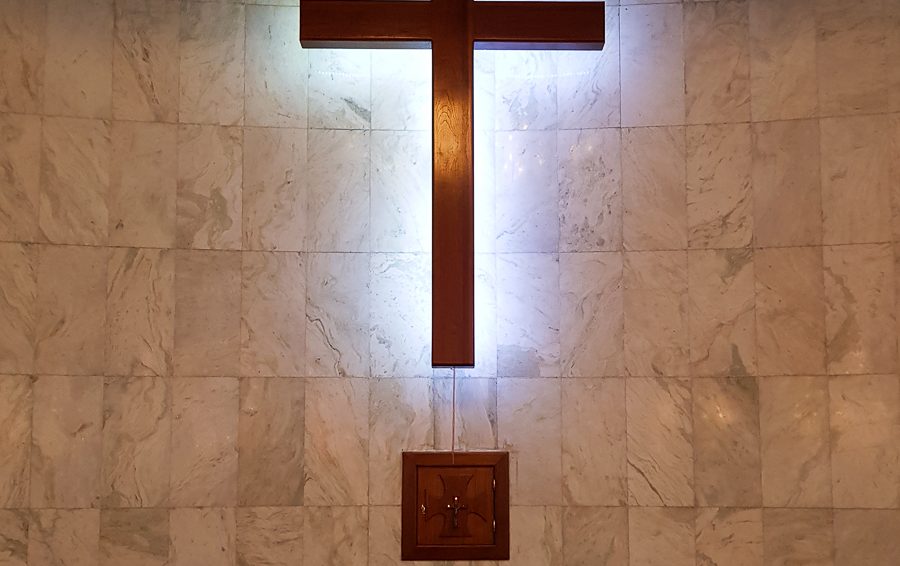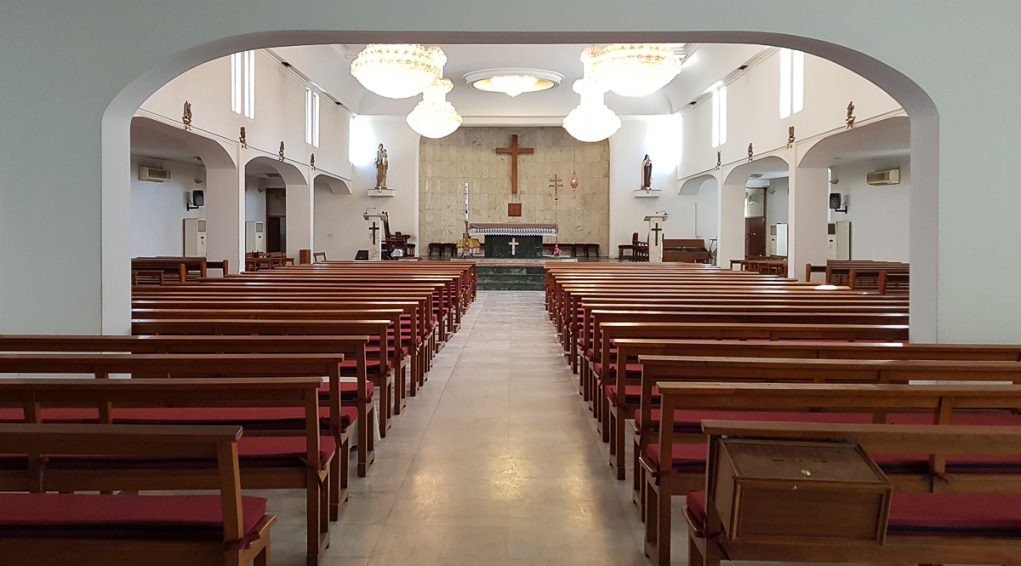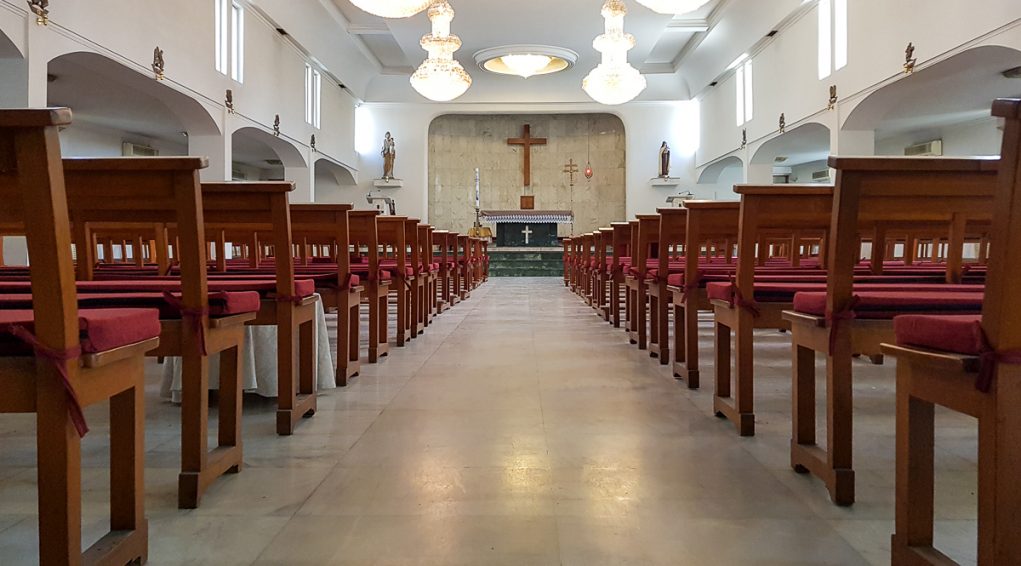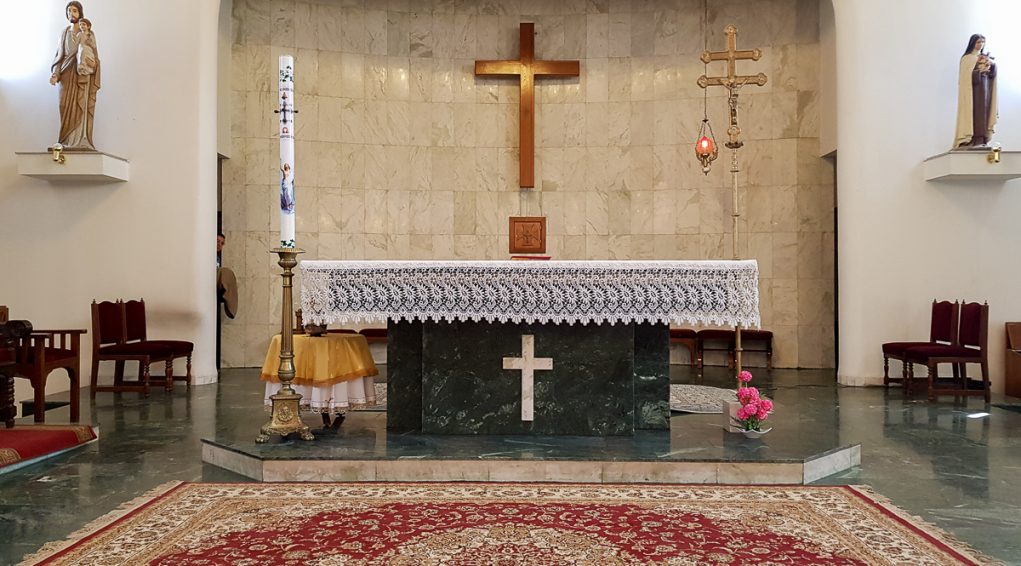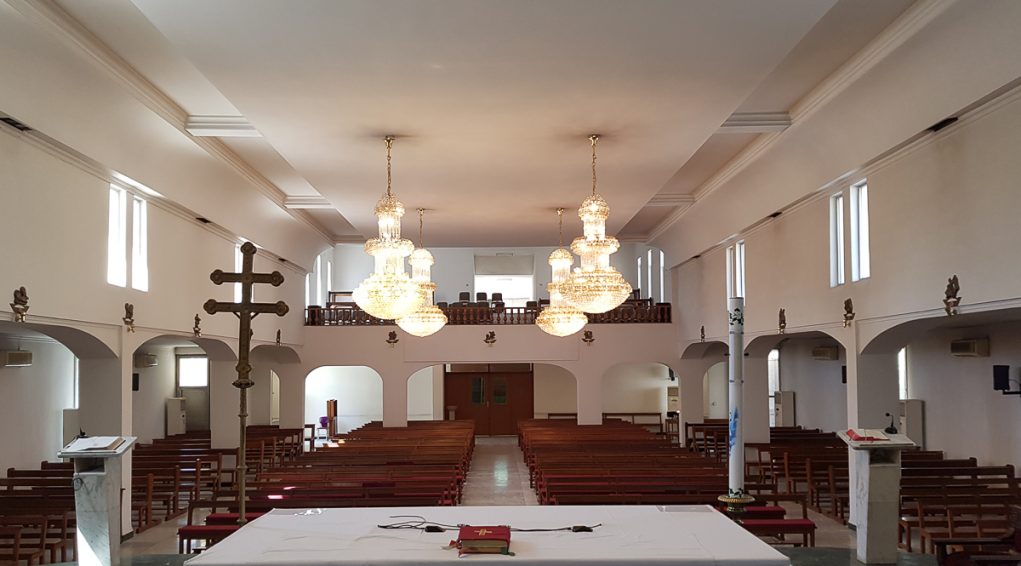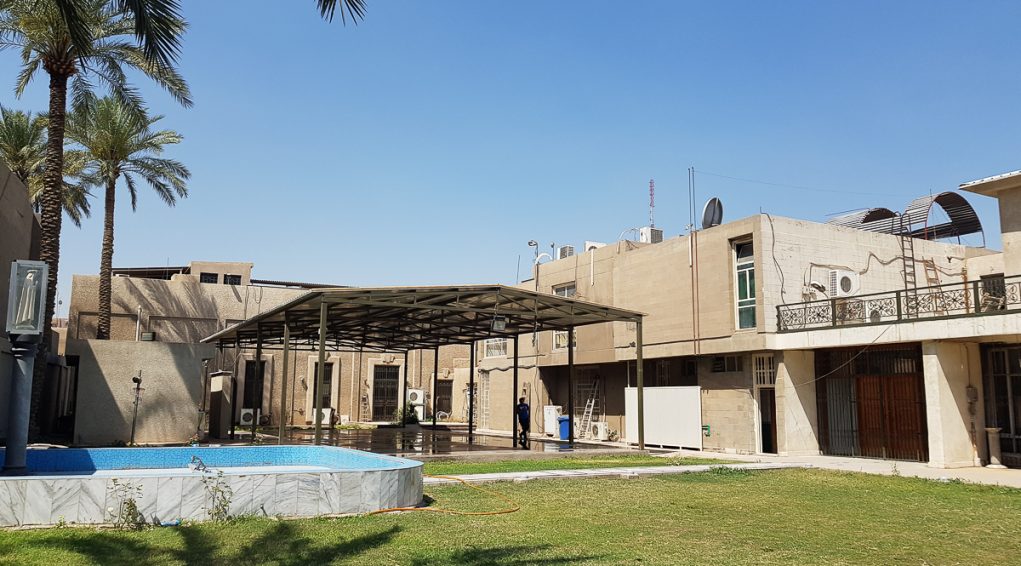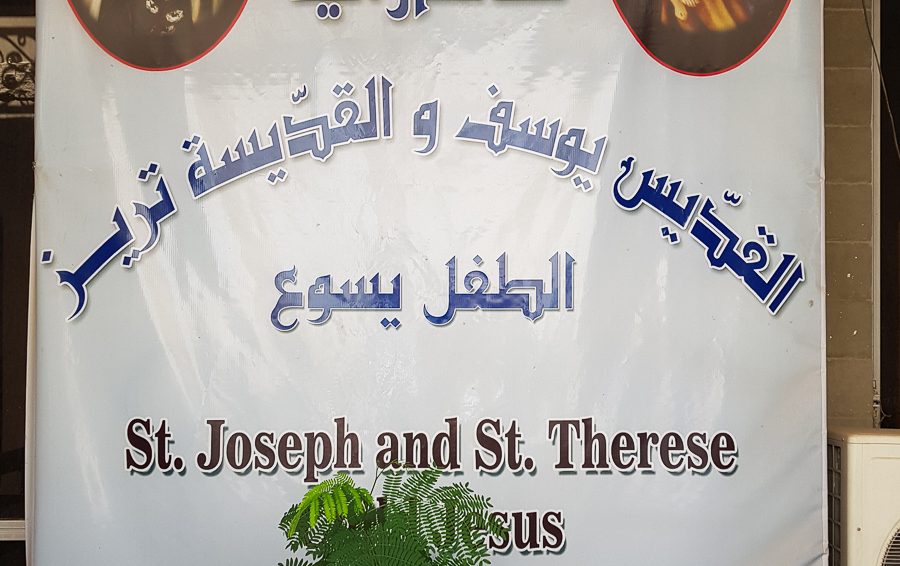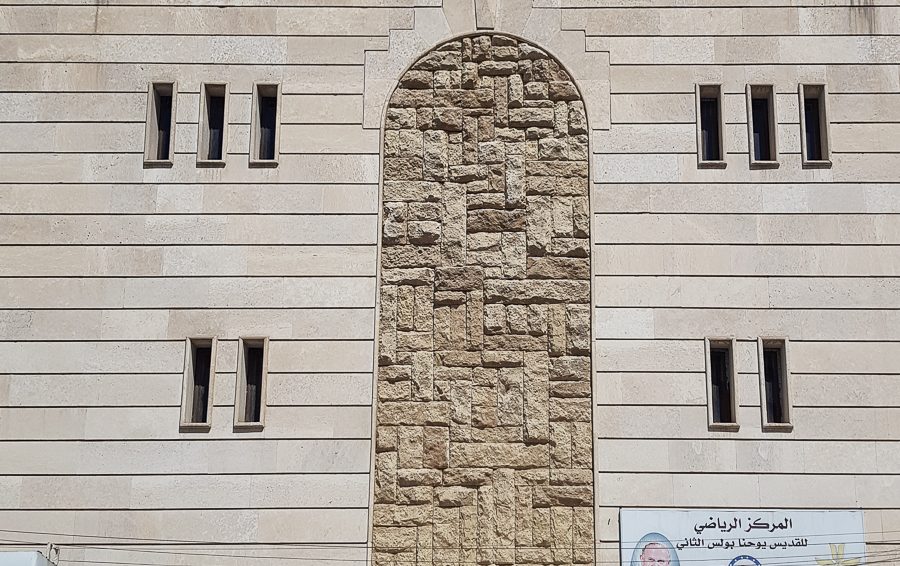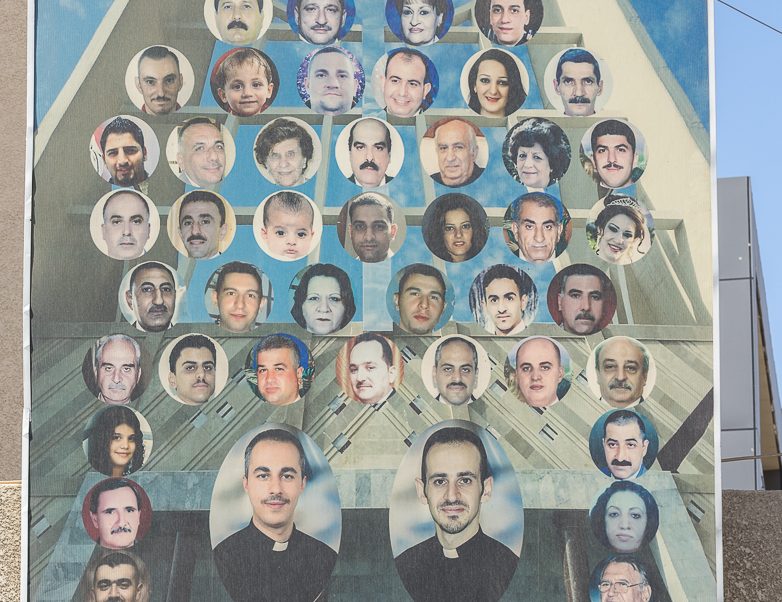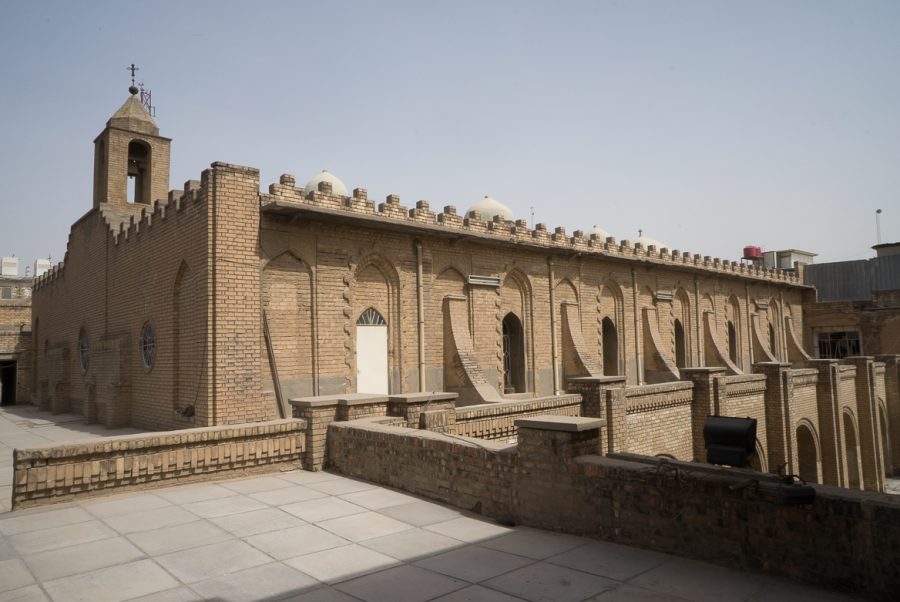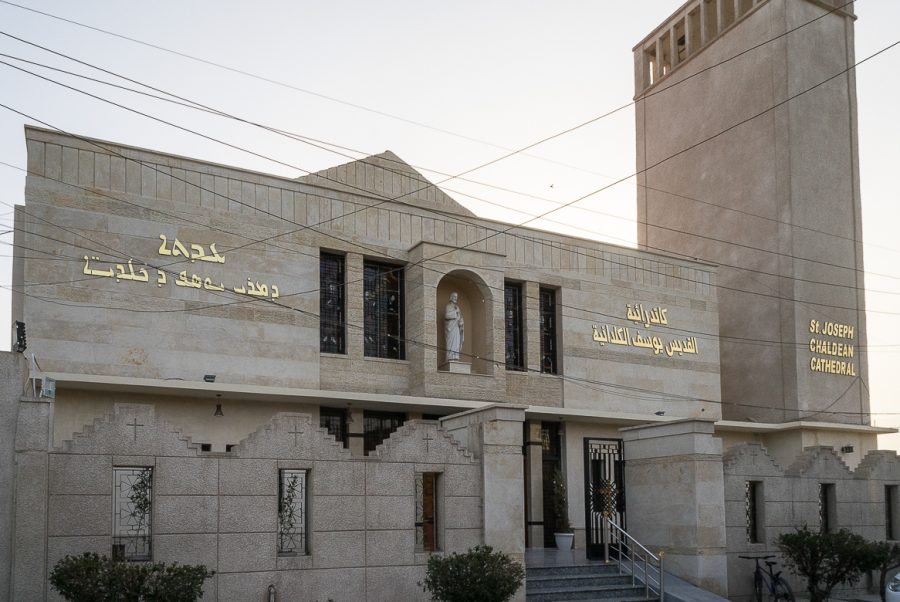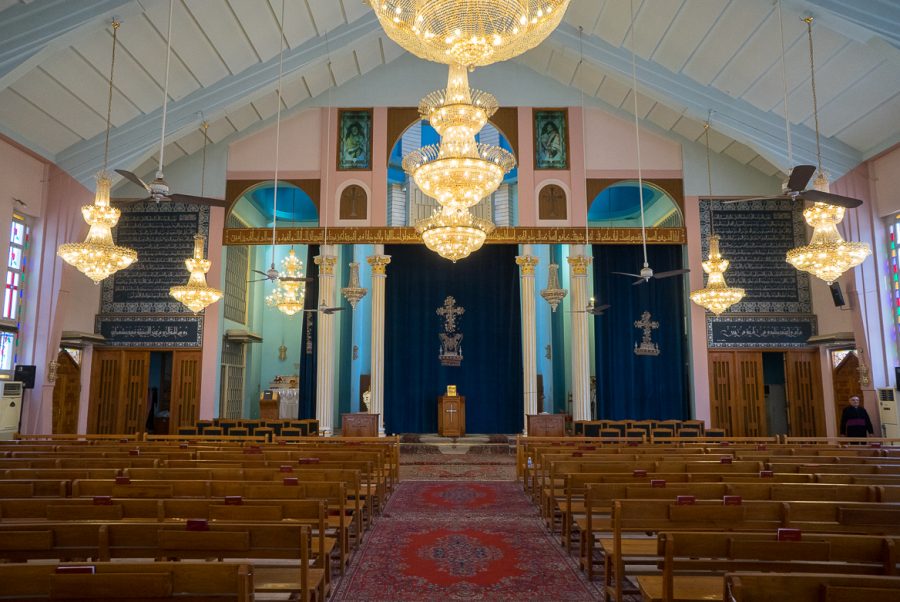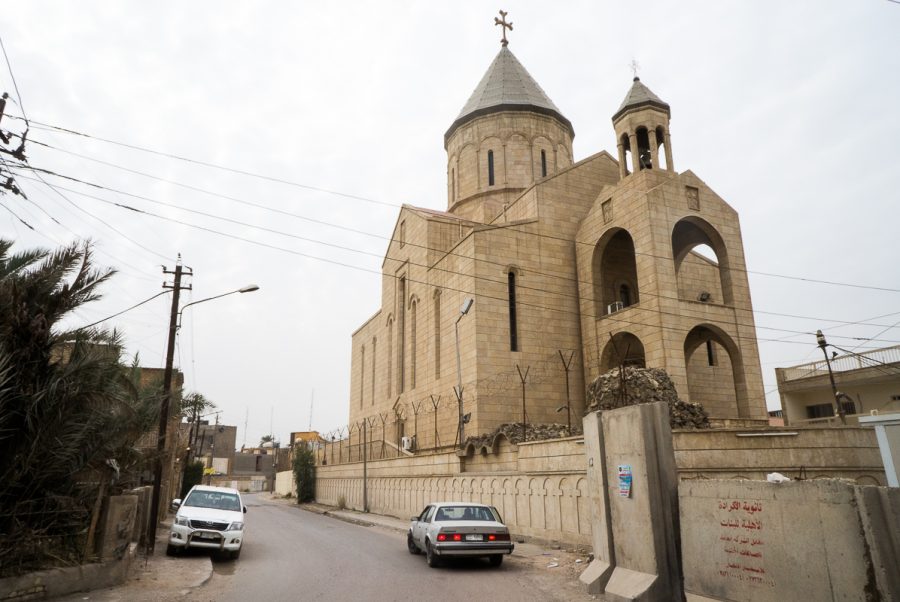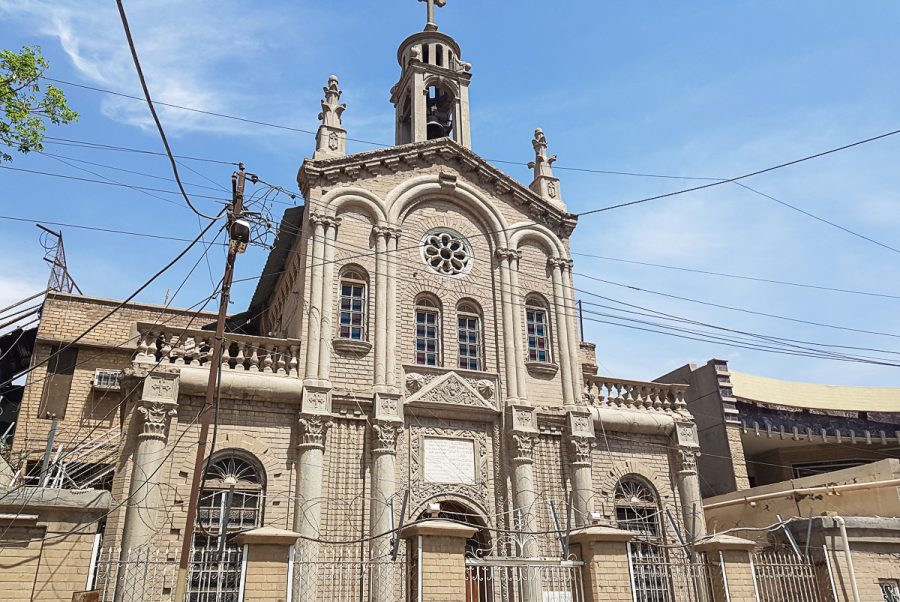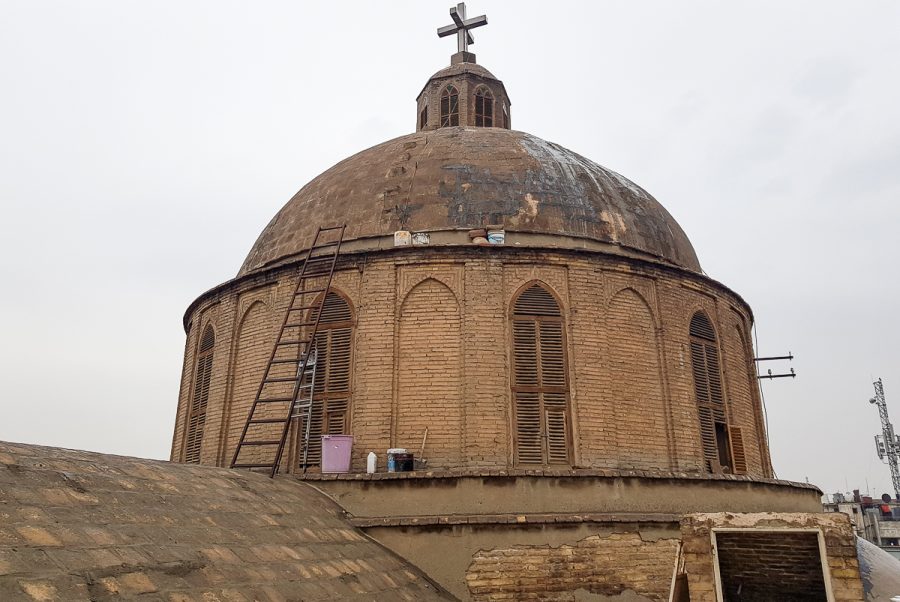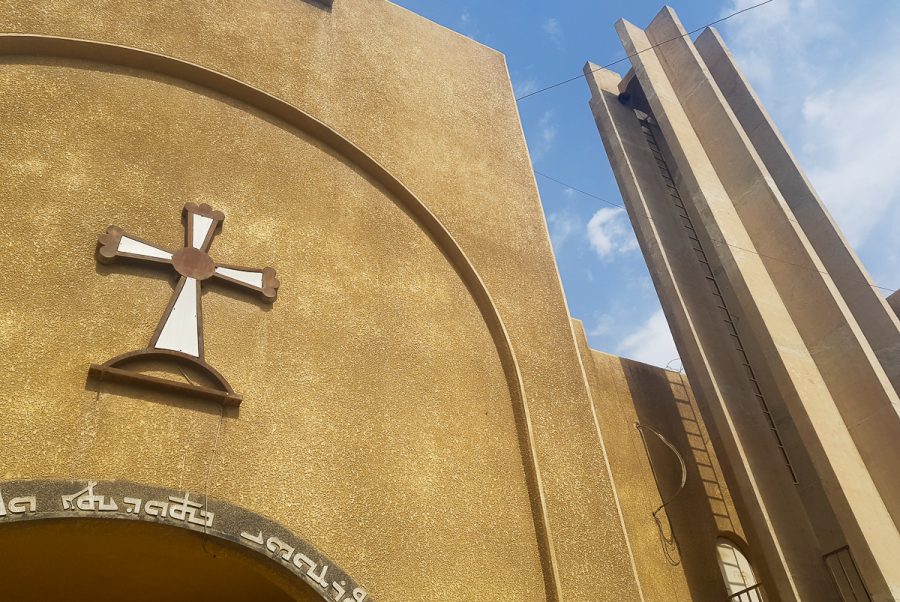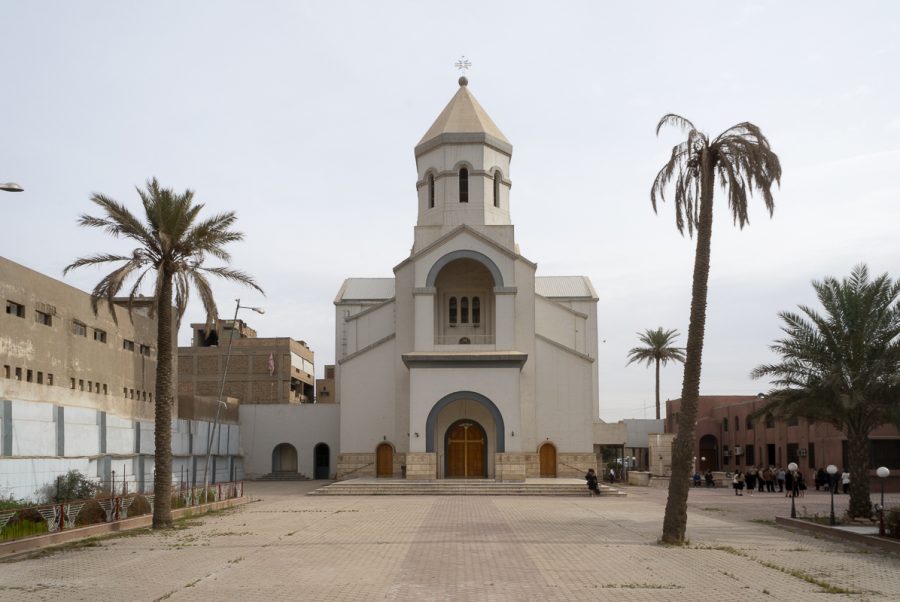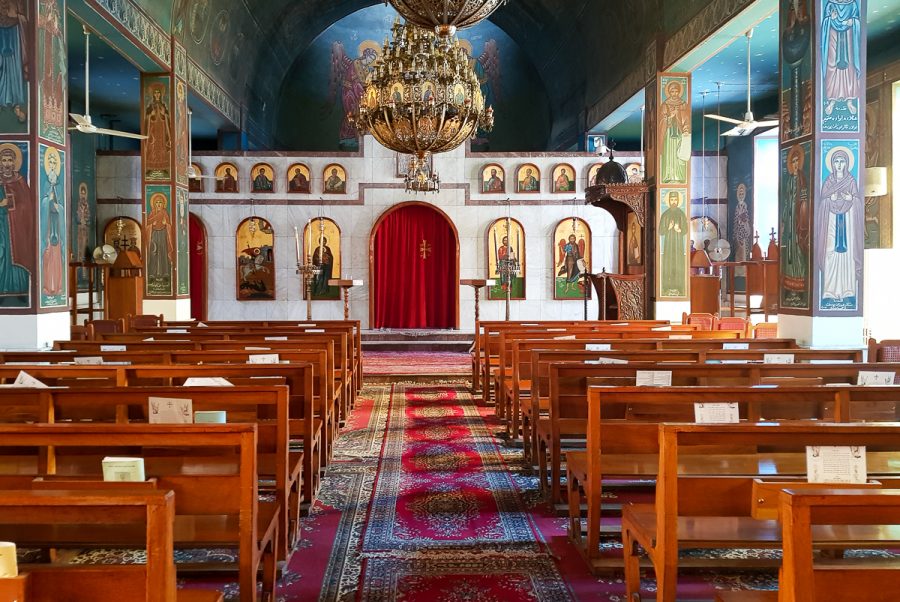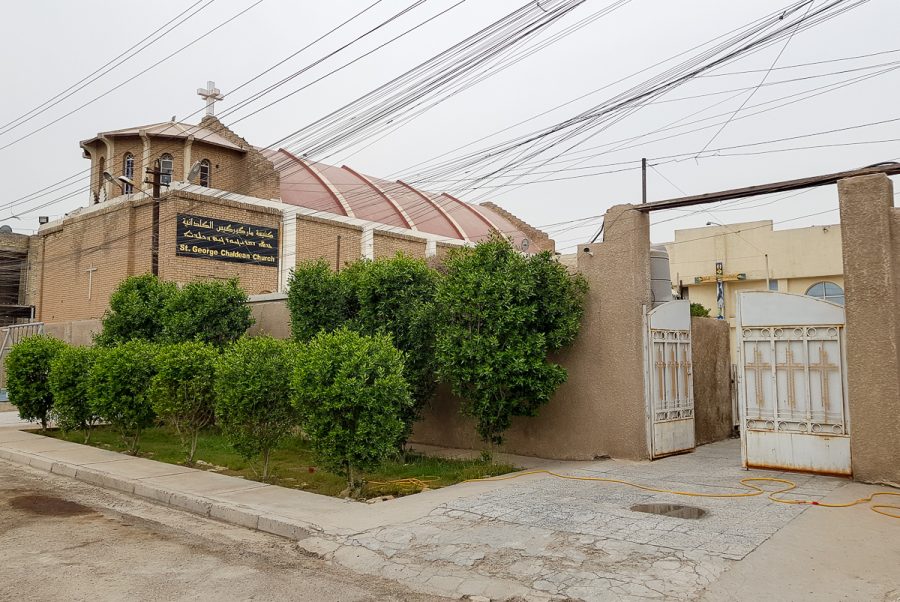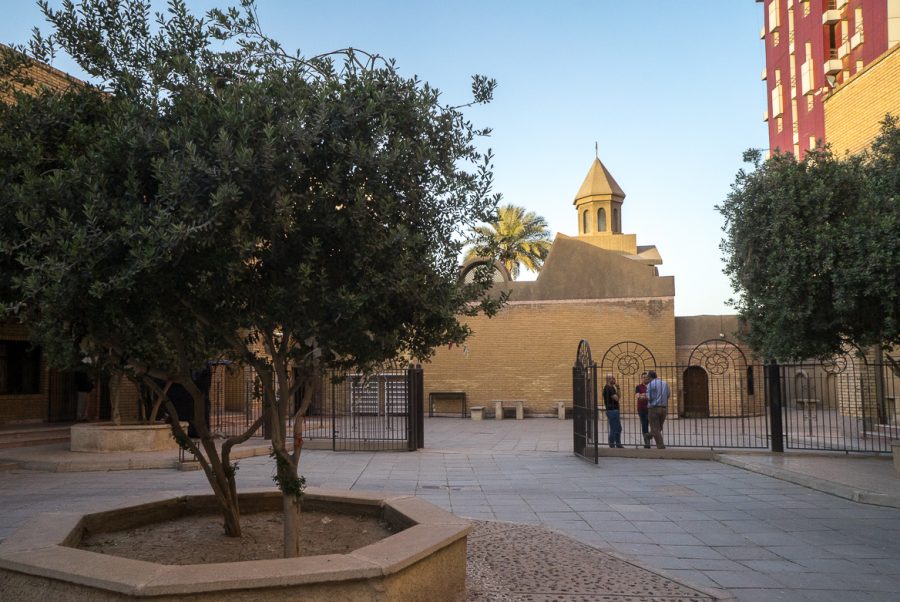The cathedral of Saint Joseph and Saint Teresa of the Child Jesus in Baghdad
The Latin cathedral of Saint Joseph and Saint Teresa of the Child Jesus in Baghdad is located at 33°18’34.0″N 44°26’05.0″E and 38 metres altitude, on the eastern bank of the Tigris.
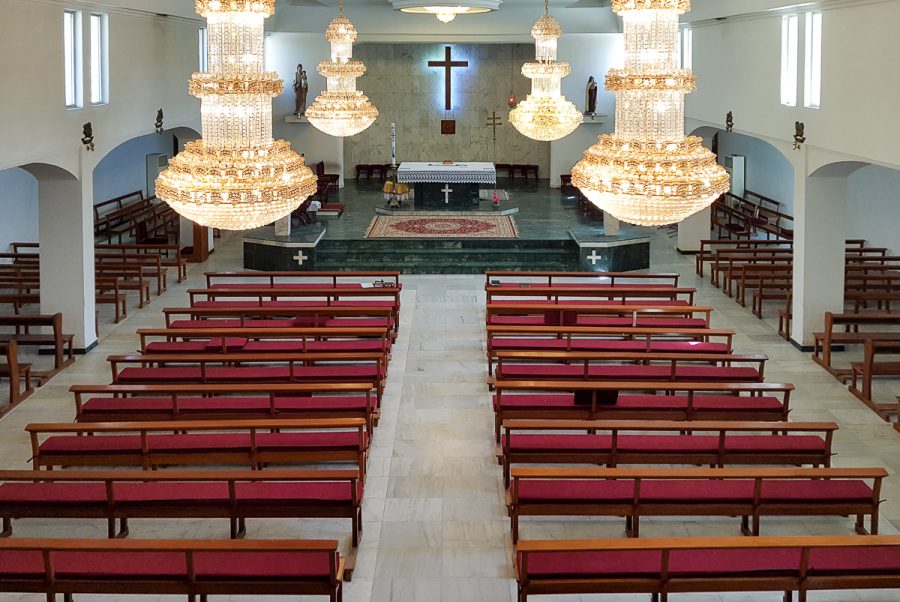
The Latin cathedral of Saint Joseph and Saint Teresa of the Child Jesus in Baghdad was built in 1984. It was originally a large room in a set of buildings used for the church’s cultural activities, known as the Christian Cultural Centre, created by the Carmelite Fathers.
The estate on which the cathedral is built contains a large garden, in the centre of which is a reconstitution of a prayer grotto dedicated to the Virgin Mary, as well as a children’s play area.
Next to the cathedral, on the right, is a retirement home, the House of Providence. On the left of the cathedral is a religious and social community centre, the Saint Joseph Centre, created and inaugurated at the time of archbishop Paul Dahdah in 1998.
Despite the small number of people baptised into the Latin church, a large variety of cultural activities and catechism are offered to people of all ages.
Pic : Latin cathedral Saint Joseph and Saint Teresa of Baghdad. April 2018. © Basil Milk Nalbandian / MESOPOTAMIA
Location
The Latin cathedral of Saint Joseph and Saint Teresa of the Child Jesus in Baghdad is located at 33°18’34.0″N 44°26’05.0″E and 38 metres altitude, on the eastern bank of the Tigris, in the Hay al-Wahda, road 42.
A summary of Christian demographics in Iraq
Although Christians who follow the Latin rites constitute a small proportion of the total Christian population in Iraq (only 1,000 people baptised in 2012, as opposed to 3,500 in 1990 and 2,500 in 2006), [1]they are often in close communion with Catholic faithful from other Chaldean denominations: Chaldean, Syriac-Catholic, Armenian and Greek Catholic. Though they undisputedly constitute the majority of Christians in Iraq, the Chaldeans numbered 750,000 in the last census in 1987, compared to 300,000 Assyrians (Church of the East and the Ancient Church of East). The total number of Christian people in Iraq amounted then to 8% of the total population. How many were there in 2018? The data collected by Mesopotamia’s correspondents confirms the demographic collapse reported by the communities visited. There are less than 400,000 Chaldeans in Iraq, living in Baghdad, Kurdistan, the Nineveh plain and Basra. The disasters faced by the Christian communities in Iraq have not ceased since its independence in 1933. There was no respite at the start of the 21st century with the American invasion in 2003 and the terrible sanctions imposed by the UN, along with the violence and persecution perpetrated by Islamicist and organised crime groups, targeting Christian communities since the fall of Saddam Hussein’s regime.
_______
[1] Source http://boowiki.info/art/dioceses-catholiques-en-irak/archidiocese-de-bagdad.html#Cronotassi_dei_vescovi
Origins of the Latin presence in Baghdad
As of 1235, one of the companions of Saint Dominique, Brother William of Monferrat was sent to the East by Pope Gregory IX. When he arrived in Mesopotamia in 1237 it is said that he went to Baghdad to the court of the Caliphate.
On 6 September 1632 the Latin diocese of Baghdad was created, at a time when the region was dominated by Persia and religious and political power was held in Isfahan. The European powers and the Holy See developed their diplomatic and religious activities in this imperial city, controlled by the Persian sovereigns, in particular under the reign of Shah Abbas I (1587 – 1629). The first bishop of Isfahan was Jean Thaddeus, who appointed the Spanish Carmelite Timoteo Perez as a co-adjudicator for Baghdad, “but neither made it to their respective episcopal seats[1].” The first Latin bishop who actually made it to Baghdad was the Carmelite Bernard of Saint Theresa (Jean Duval). He celebrated mass there in 1642 before returning to France. The 17th century marked the opening of the Latin missions in Iraqi Mesopotamia. The Capuchin Friars opened their first house in Mosul in 1636 and also deployed their missionary activities in Baghdad in the 17th and 18th centuries.
It was not until 21st December 1743 with the episcopal consecration of the Carmelite Emmanuel de Saint-Albert (Jean-Claude Ballyet, known as Dom Emmanuel Ballyet de Saint-Albert de Saint-Antoine, 1702-1773) at the seat of Babylon, that the Latin Bishop of Baghdad was properly installed. Pro-vicar of Baghdad since 1728, he was also named French Consul to Baghdad in 1741 before being appointed bishop. He built a hospice, school and episcopal residence. He died from the plague in Baghdad in 1773.
In 1820 the Frenchman Pierre-Alexandre Coupperie (1770 – 1831) was appointed Latin bishop of Babylon. He played a vital role in supporting the union of the Chaldean church with Rome. Also named French Consul to Baghdad in 1823, he engaged in extensive diplomatic and religious correspondence. On his death in 1831, he was remembered as an admirable prelate and a man who took care of the most deprived during periods of famine and plague: “ a holy man” as the current Latin archbishop of Baghdad, since November 2000, Jean-Benjamin Sleiman from Lebanon, likes to recall.
_______
[1] In “L’Église en Irak. Les Chrétiens ont-ils un avenir en Irak ? Sera-ce un avenir de paix ?” Fernando Filoni, prefect of the congregation for the evangelisation of the people. Former apostolic nuncio in Iraq. Revue Perspectives & Réflexions, n°6 – 2018, published by Œuvre d’Orient, November 2018, p. 99
History of the Latin cathedral of Saint Joseph and Saint Teresa of the Child Jesus in Baghdad
The Latin cathedral of Saint Joseph and Saint Teresa of the Child Jesus in Baghdad was built in 1984. At its inauguration it was named Saint Joseph, like the former Latin cathedral in the ancient Christian neighbourhood of Chorjah, in Aqued el Nassara (see file). The name Saint Teresa of the Child Jesus was added at a later date.
The cathedral was originally a large room in a set of buildings used for the church’s cultural activities, known as the Christian Cultural Centre, created by the Carmelite Fathers. The room was transformed into a church at the time of Monsignor Ernest-Marie de Jésus-Hostie Charles Albert Nyary, at the instigation of the Dominican Father Abd Al-Salam Helwa.
In 2004, the interior of the church was renovated.
Despite the small number of people baptised into the Latin church, a large variety of cultural activities and catechism are offered to people of all ages.
Description of the Latin cathedral of Saint Joseph and Saint Teresa of the Child Jesus in Baghdad
The interior layout of the cathedral is the result of the major renovation work undertaken in 2004. The floor is tiled. The walls and ceiling are painted white. It is a triple-nave building. Above the entrance, in line with the choir, a large tribune occupies the full width of the central nave. The choir of the church, raised by three steps in relation to the nave, is covered with the same dark greyish-green marble which adorns the high altar. Above this is a cupola with light fittings. A modest tabernacle is recessed into the concave wall of the apse chapel, enhanced with beige tiling. Above it stands a large Latin cross made of varnished wood. Two statues, one of St Teresa the Child Jesus and the second of Saint Joseph stand either side to the rear of the altar. Large pseudo three-centred arches with rectangular pillars separate the central nave from the side aisles. The stations of the cross surround the nave. Throughout the church the upper and lower windows allow in large amounts of natural light, in addition to the two rows of chandeliers.
Around the cathedral: The estate on which the cathedral is built contains a large garden, in the centre of which is a reconstitution of a prayer grotto dedicated to the Virgin Mary, as well as a children’s play area.
Next to the cathedral, on the right, is a retirement home, the House of Providence. On the left of the cathedral is a religious and social community centre, the Saint Joseph Centre, created and inaugurated at the time of archbishop Paul Dahdah in 1998.
Monument's gallery
Monuments
Nearby
Help us preserve the monuments' memory
Family pictures, videos, records, share your documents to make the site live!
I contribute